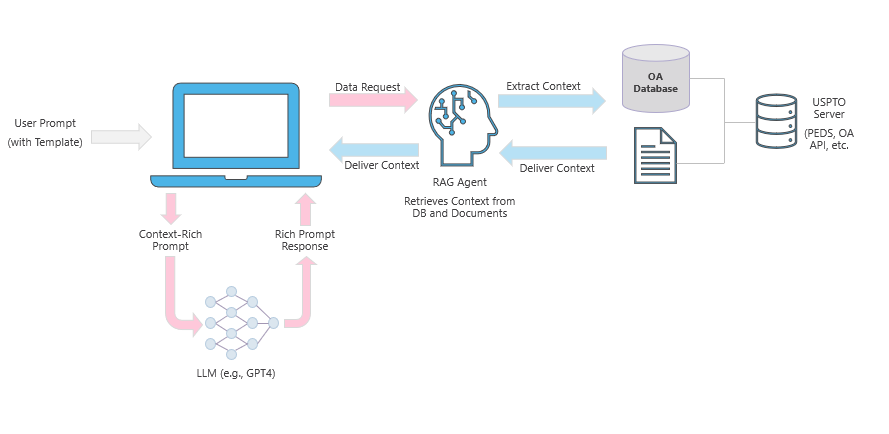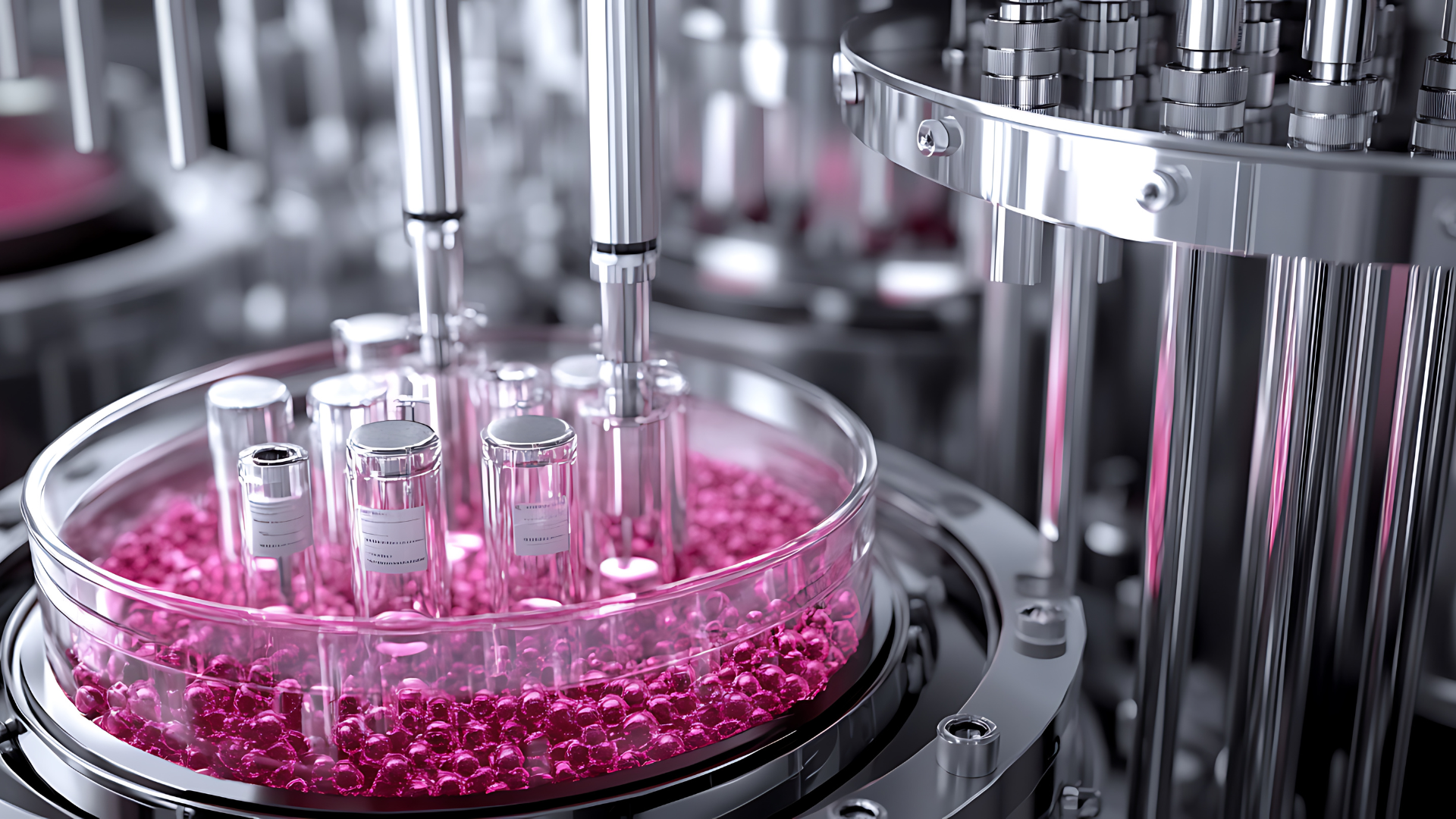In today’s fast-paced technological landscape, the field of Intellectual Property (IP) research, analytics, and patent prosecution faces the challenge of efficiently handling vast amounts of data. The introduction of Retrieval-Augmented Generation (RAG) is poised to revolutionize how these tasks are approached, blending the power of information retrieval with the sophistication of generative AI to transform patent prosecution.
With the global Artificial Intelligence in Legal Services Market projected to expand at a compound annual growth rate (CAGR) of 32.5% during the forecast period, reaching a value of USD 45.80 billion by 2030, the adoption of AI technologies, such as RAG, is on the rise. This statistic highlights the growing importance of incorporating advanced AI solutions in intellectual property to meet data management and analysis demands and challenges.
This paper explores RAG's transformative impact on patent prosecution and its potential to enhance efficiency and accuracy in this complex domain. By leveraging RAG's capabilities, professionals in the field can streamline their workflows, improve decision-making, and ultimately deliver better client outcomes.
Understanding Generative AI and RAG
Generative AI encompasses a wide range of models in machine learning and deep learning, including classic generative models like Naïve Bayes and Hidden Markov models, as well as more advanced deep generative models such as Generative Adversarial Networks (GANs) and autoregressive models. Autoregressive models such as GPT 4 (by OpenAI) have gained significant attention due to their ability to produce highly realistic and coherent text.
RAG combines the strengths of information retrieval (IR) and generative AI to create a powerful tool for various applications. In the context of patent prosecution, this means using IR algorithms to sift through vast corpora of documents to find relevant information and then employing generative models to produce detailed, contextually accurate responses. This approach not only streamlines the workflow but also significantly enhances the quality of the output.
Role of RAG in Patent Prosecution
Patent prosecution is a complex and time-consuming activity that involves numerous tasks, such as validation of the patent examiner’s assertions given in the Office Actions, recommendation of different strategies to overcome the examiner’s objections/rejections, suggestions for claim amendments, argument formulation, case law analysis, new claims identification, and methods for directed prosecution, etc. Traditionally, these tasks could take significant time, i.e., 1-2 days, to complete, demanding extensive manual effort from patent analysts and drafters. However, integrating generative AI and predefined prompt templates offers a game-changing solution for handling Patent prosecution.
As mentioned above, Patent prosecution involves numerous tasks that are traditionally time-consuming and require significant manual effort. Thus, by leveraging RAG, we can automate and optimize these processes, leading to substantial time savings and improved accuracy.
For better understanding, refer to FIG. 1 below, which provides a RAG workflow for patent prosecution as a clear visual representation of how this innovative technology can be integrated into the process. Let's walk through each component of this workflow and understand its significance.

The first step in applying RAG to patent prosecution is to define the task and prepare the query. For instance, if the goal is to validate the examiner’s mapping or assertions in the office actions, the query must capture relevant sections, paragraph citations, claims, and other pertinent information. This precise definition ensures that the IR algorithms can retrieve the necessary documents accurately.
Once the task is defined, IR algorithms such as TF-IDF, BM25, or more advanced learning-to-rank algorithms are employed to search large volumes of text documents. These algorithms rank the documents based on their relevance to the query, allowing the most pertinent information to be quickly identified.
After retrieving the relevant documents, the next step is to inject this text into a generative AI model like OpenAI GPT-4 using a curated prompt template. This template provides a structured framework for the model, ensuring it can accurately analyze, summarize, and extract critical information. For example, in validating the examiner’s mapping, the model can examine the context in which specific terms appear and verify their accuracy against the retrieved documents.
A crucial component of the RAG approach is the feedback loop. If the initial retrieval does not yield the desired results, the query can be adjusted, and the process is repeated. This iterative approach ensures continuous improvement in the accuracy and relevance of the generated responses.
Enhanced Workflow with Prompt Engineering
Fig. 2 further illustrates the integration of RAG in patent prosecution through a detailed prompt engineering workflow:

Step-by-Step Explanation of RAG Integration in Patent Prosecution:
- Document Gathering:
The patent analyst begins by compiling all relevant documents associated with a specific patent application. The relevant documents include:
- Office actions (current and past)
- Responses to past Office Actions
- Originally filed patent application
- Prior art documents
- Any specific instruction from the client/inventor
- Target product details
- Miscellaneous documents like examiner interview summary/advisory records
- Task Selection:
The analyst then chooses a specific task from a pre-defined dropdown menu. Common tasks include:
- Validation of Examiner Mapping or assertions in the Office Action.
- Suggestions of claim amendments to overcome the examiner’s objections/rejections.
- Drafting of the response to Office Actions.
- Crafting a persuasive argument highlighting the difference between the scope claims and the prior arts cited in the Office Action.
- Prompt Generation:
- Based on the selected task, the system automatically generates a customized prompt. This prompt incorporates content and context from the user-provided documents.
- Essentially, the RAG system injects relevant information from these documents into the prompt.
- Prompt Review and Editing:
- The patent analyst reviews the generated prompt to ensure accuracy and completeness. This step is critical for maintaining the quality and relevance of the final output.
- The analyst may edit the prompt to provide the AI with the most accurate and focused direction.
- Prompt Execution and Output Generation:
- Once finalized, the RAG system executes the validated prompt.
- The resulting output is then exported into a report format, such as a Word document.
- Utilization of Output:
- This generated report can be used for further analysis or directly submitted as part of the patent prosecution process.
In the future, plain vanilla RAG may evolve to incorporate multiagent RAG, which involves assigning different RAG agents to work independently on specific portions of a task. This approach enables the generation of more advanced reasoning capabilities that cannot be achieved through a single query in patent prosecution. By dividing the task among multiple agents, each agent can focus on their assigned portion and hand over the output to other agents. This collaborative approach significantly enhances the overall efficiency and effectiveness of the process. A pertinent utility of this approach would be preparing an end-to-end office action response using multi-agent RAG. In this scenario, separate agents can be designated for analyzing the examiner’s assertions, evaluating amendment strategies, amendments to the claims, and argument writing.
The integration of RAG in patent prosecution offers several significant benefits:
- Time Savings: Automating labor-intensive tasks drastically reduces the time required for analysis. What once took days can now be accomplished within minutes, allowing analysts to focus on higher-value activities and boosting overall productivity.
- Enhanced Quality: RAG’s ability to provide detailed, contextually accurate analysis improves the quality of office action strategies. Analysts can explore multiple approaches and select the optimal ones, leading to better-informed decisions and higher-quality outputs.
- Accelerated Response Review: By streamlining the workflow, RAG expedites the review of office action responses. This efficiency gain positively impacts the timeliness of patent prosecution projects, reducing the overall decision-making process.
Outlook and Challenges
While RAG exhibits great promise, it is essential to acknowledge its current limitations and anticipate future developments:
- Mitigating Generative AI Imperfections: As generative AI is still developing, inaccuracies can arise. Combining AI with human expertise ensures reliable outputs through close supervision and quality control.
- Rise of Specialist AIs: As AI models receive more domain-specific training, their accuracy and contextual understanding will improve. This development will likely lead to the emergence of specialist AIs tailored to the nuances of intellectual property research and patent prosecution, opening new possibilities for expanding use cases and enhancing accuracy.
- Data Security and Privacy: As RAG relies on vast amounts of data, robust security measures are crucial to safeguard sensitive information and comply with data privacy regulations.
- Legal and Ethical Considerations: The implications of AI-generated outputs in legal contexts like patent prosecution must be carefully considered. Establishing clear ethical guidelines and ensuring human oversight remain paramount.
- Integration with Existing Systems: Seamless integration of RAG technology with existing patent prosecution software and workflows will be essential for maximizing its adoption and minimizing disruption.
Conclusion
The introduction of RAG marks a groundbreaking leap in patent prosecution. By harnessing the capabilities of generative AI, we can streamline prosecution workflows, improve output quality, and accelerate response reviews. As generative AI evolves, its transformative potential will only grow, enabling us to deliver more excellent value to our clients. As we continue to explore and refine this technology, the possibilities for its application will only expand, promising a more efficient and practical approach to managing intellectual property.
At Evalueserve IP and R&D, we are committed to embracing cutting-edge technologies like generative AI to drive innovation and optimize patent prosecution. Join us on this transformative journey as we reshape the future of intellectual property research and empower our clients with intelligent solutions.
Talk to One of Our Experts
Get in touch today to find out about how Evalueserve can help you improve your processes, making you better, faster and more efficient.



